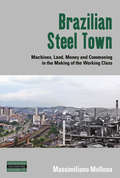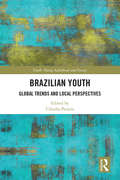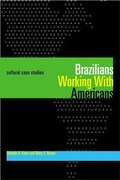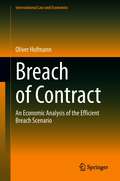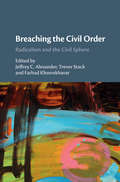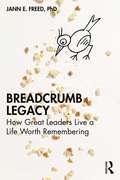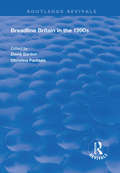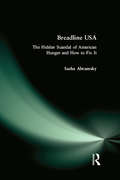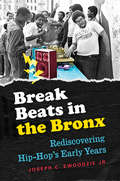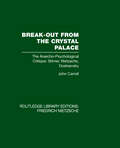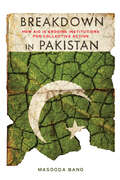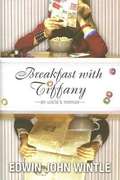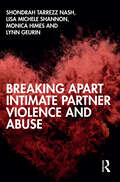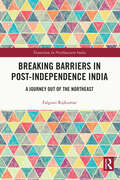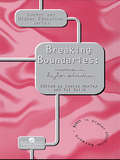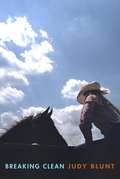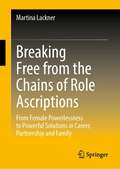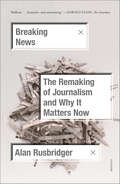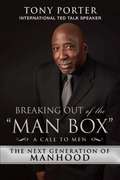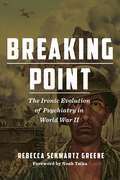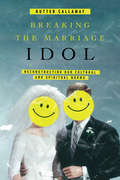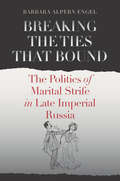- Table View
- List View
Brazilian Steel Town: Machines, Land, Money and Commoning in the Making of the Working Class (Dislocations #27)
by Massimiliano MollonaVolta Redonda is a Brazilian steel town founded in the 1940s by dictator Getúlio Vargas on an ex-coffee valley as a powerful symbol of Brazilian modernization. The city’s economy, and consequently its citizen’s lives, revolves around the Companha Siderurgica Nacional (CSN), the biggest industrial complex in Latin America. Although the glory days of the CSN have long passed, the company still controls life in Volta Redonda today, creating as much dispossession as wealth for the community. Brazilian Steel-Town tells the story of the people tied to this ailing giant – of their fears, hopes, and everyday struggles.
Brazilian Youth: Global Trends and Local Perspectives (Youth, Young Adulthood and Society)
by Cláudia PereiraThe collection brings together texts of Brazilian researchers who are dedicated to themes related to studies of youth cultures: sociabilities, subcultures, identities and belonging, pop culture, social movements, migration, consumption and materialities, generational exchanges, media representations and digital media, among others. The objective is to promote a broad dialogue that includes fields of knowledge such as Communication and Social Sciences, as well as local perspectives that represent the huge and rich diversity of the Brazilian regions. At the same time, the book proposes to discuss the reflexivity of such local youth cultures in the face of a global context that challenges, with ruptures and permanencies, the very idea of youth. The book seeks to fill the gap of a selection of scientific texts by Brazilian authors, about Brazilian youth cultures, aimed at foreign researchers.
Brazilians Working With Americans/Brasileiros que trabalham com americanos: Cultural Case Studies/Estudos de casos culturais
by Kelm Orlando R. Risner Mary E.Brazilians Working With Americans presents ten short case studies that effectively illustrate many of the cultural factors that come into play when North American business professionals work in Brazil. The authors summarize each case and the aspects of culture it involves, and American and Brazilian executives comment on the cultural differences highlighted by that case. A list of topics and questions for discussion also help draw out the lessons of each business situation. To make the book equally useful to Brazilians and Americans (whether businesspeople or language students), the entire text is presented in both English and Portuguese.
Breach of Contract: An Economic Analysis of the Efficient Breach Scenario (International Law and Economics)
by Oliver Hofmann“Efficient breach” is one of the most discussed topics in the literature of law and economics. What remedy incentivizes the parties of a contract to perform contracts if and only if it is efficient? This book provides a new perception based on an in-depth analysis of the impact the market structure, asymmetry of information, and deviations from the rational choice model have, comprehensively. The author compares the two predominant remedies for breach of contract which have been adopted by most jurisdictions and also found access to international conventions like the Convention on Contracts for the International Sale of Goods (CiSG): Specific performance and expectation damages. The book illustrates the complexity such a comparison has under more realistic assumptions. The author shows that no simple answer is possible, but one needs to account for the circumstances. The comparison takes an economic approach to law applying game theory. The game-theoretic models are consistent throughout the entire book which makes it easy for the reader to understand what effects different assumptions about the market structure, the distribution of information, and deviations from the rational choice model have, and how they are intertwined.
Breaching the Civil Order: Radicalism and the Civil Sphere
by Jeffrey C. Alexander Farhad Khosrokhavar Trevor StackIt is not only a paradox but something of an intellectual scandal that, in an era so shaken by radical actions and ideologies, social science has had nothing theoretically new to say about radicalism since the middle of the last century. Breaching the Civil Order fills this void. It argues that, rather than seeing radicalism in substantive terms - as violent or militant, communist or fascist - radicalism should be seen more broadly as any organized effort to breach the civil order. The theory is brilliantly made flesh in a series of case studies by leading European and American social scientists, from the destruction of property in the London race riots to the public militancy of Black Lives Matter in the US, the performative violence of the Irish IRA and the Mexican Zapatistas to the democratic upheavals of the Arab Spring, and from Islamic terrorism in France to Germany's right-wing populist Pegida.
Breadcrumb Legacy: How Great Leaders Live a Life Worth Remembering
by Jann E. FreedLegacy can seem far off and out of reach, but it doesn’t happen at journey’s end and it’s not only for the rich and famous. Legacy is now, and this book shows leaders how you can find and leave meaning on a daily basis. Jann E. Freed, PhD, introduces her Breadcrumb Legacy™ framework, a radical but pragmatic approach, made up of small actions you consciously take over time that accumulate into the trail, or legacy, you’ll leave behind. Breadcrumb Legacy is also a mindset, an awareness of the impact you’re having on your relationships, your organization, and your family, in every communication and interaction. This book is the guide to leaving a trail of meaning throughout your life and career. Based on in-depth interviews, Breadcrumb Legacy provides inspiration and practical stories for living a life worth remembering.
Breadline Britain in the 1990s (Routledge Revivals)
by David Gordon Christina PantazisFirst published in 1997, this series, published in association with the Social Policy Research Unity at the University of York, is designed to inform public debate about these policy areas and to make the details of important policy-related research more widely available.
Breadline USA: The Hidden Scandal of American Hunger and How to Fix It
by Sasha AbramskyTwenty-five million Americans—nearly 9 percent of the U.S. population—rely on food pantries. Another 13 million aren’t linked to a food distribution network, and 14 million children are at risk of going hungry on any given day. Moreover, the faltering economy is increasing the number of American families that don’t know where their next meals are coming from.Breadline USA treats this crisis not only as matter of failed policies, but also as a portrait of real human suffering. Investigative reporter Sasha Abramsky focuses attention on the people behind the statistics—the families caught up in circumstances beyond their control. Breadline USA is a vivid reminder of the fate to which many more Americans may be subject without urgent action.
Breadwinning Daughters
by Katrina SrigleyAs one of the most difficult periods of the twentieth century, the Great Depression left few Canadians untouched. Using more than eighty interviews with women who lived and worked in Toronto in the 1930s, Breadwinning Daughters examines the consequences of these years for women in their homes and workplaces, and in the city's court rooms and dance halls.In this insightful account, Katrina Srigley argues that young women were central to the labour market and family economies of Depression-era Toronto. Oral histories give voice to women from a range of cultural and economic backgrounds, and challenge readers to consider how factors such as race, gender, class, and marital status shaped women's lives and influenced their job options, family arrangements, and leisure activities. Breadwinning Daughters brings to light previously forgotten and unstudied experiences and illustrates how women found various ways to negotiate the burdens and joys of the 1930s.
Break Beats in the Bronx: Rediscovering Hip-Hop's Early Years
by Joseph C. EwoodzieThe origin story of hip-hop—one that involves Kool Herc DJing a house party on Sedgwick Avenue in the Bronx—has become received wisdom. But Joseph C. Ewoodzie Jr. argues that the full story remains to be told. In vibrant prose, he combines never-before-used archival material with searching questions about the symbolic boundaries that have divided our understanding of the music. In Break Beats in the Bronx, Ewoodzie portrays the creative process that brought about what we now know as hip-hop and shows that the art form was a result of serendipitous events, accidents, calculated successes, and failures that, almost magically, came together. In doing so, he questions the unexamined assumptions about hip-hop's beginnings, including why there are just four traditional elements—DJing, MCing, breaking, and graffiti writing—and not others, why the South Bronx and not any other borough or city is considered the cradle of the form, and which artists besides Kool Herc, Afrika Bambaataa, and Grandmaster Flash founded the genre. Ewoodzie answers these and many other questions about hip-hop's beginnings. Unearthing new evidence, he shows what occurred during the crucial but surprisingly underexamined years between 1975 and 1979 and argues that it was during this period that the internal logic and conventions of the scene were formed.
Break Point: Two Minnesota Athletes and the Road to Title IX
by Sheri BrendenHow two teenage girls in Minnesota jump-started a revolution in high school athletics Peggy Brenden, a senior, played tennis. Toni St. Pierre, a junior, was a cross country runner and skier. All these two talented teenagers wanted was a chance to compete on their high school sports teams. But in Minnesota in 1972 the only way on the field with the boys ran through a federal court—so that was where the girls went. Break Point tells the story, for the first time, of how two teenagers took on the unequal system of high school athletics, setting a legal precedent for schools nationwide before the passage of Title IX.As Peggy&’s younger sister, author Sheri Brenden is uniquely positioned to convey the human drama of the case, the stakes, and the consequences for two young women facing the legal machinery of the state, in court and in school. In an account that begins with Peggy painstakingly typing her appeal to the Minnesota Civil Liberties Union and concludes with a long view of what Brenden v. Independent School District 742 set in motion, Sheri Brenden summons the salient details of this landmark case as it makes its way through the courts. Peggy and Toni, coaches, administrators, and experts testify before Judge Miles Lord, whose decision, upheld in a precedent-setting appeal, would change these girls&’ lives and open up athletic opportunities for innumerable others.Grounded in newspaper coverage, court records, and interviews, Brenden&’s deeply researched, scrupulously reported book is at heart the story of two talented teenage girls whose pluck and determination—and, often, heartache—led to a victory much greater than any high school championship.
Break-Out from the Crystal Palace: The Anarcho-Psychological Critique: Stirner, Nietzsche, Dostoevsky (Rouledge Library Editions: Friedrich Nietzsche)
by John CarrollBefore Marcuse and Laing, before Heidegger and Sartre, even before Freud, the way was prepared for the anarcho-psychological critique of economic man, of all codes of ideology or absolute morality, and of scientific habits of mind. First published in 1974, this title traces this philosophical tradition to its roots in the nineteenth century, to the figures of Stirner, Nietzsche and Dostoevsky, and to their psychological demolition of the two alternative axes of social theory and practice, a critique which today reads more pertinently than ever, and remains unanswered. To understand this critique is crucial for an age which has shown a mounting revulsion at the consequences of the Crystal Palace, symbol at once of technologico-industrial progress and its rationalist-scientist ideology, an age whose imaginative preoccupations have telescoped onto the individual, and whose interest has switched from the social realm to that of anarchic, inner, 'psychological man'.
Breakdown in Pakistan: How Aid Is Eroding Institutions for Collective Action
by Masooda BanoThirty percent of foreign development aid is channeled through NGOs or community-based organizations to improve service delivery to the poor, build social capital, and establish democracy in developing nations. However, growing evidence suggests that aid often erodes, rather than promotes, cooperation within developing nations. This book presents a rare, micro level account of the complex decision-making processes that bring individuals together to form collective-action platforms. It then examines why aid often breaks down the very institutions for collective action that it aims to promote. Breakdown in Pakistan identifies concrete measures to check the erosion of cooperation in foreign aid scenarios. Pakistan is one of the largest recipients of international development aid, and therefore the empirical details presented are particularly relevant for policy. The book's argument is equally applicable to a number of other developing countries, and has important implications for recent discussions within the field of economics.
Breakfast with Tiffany: An Uncle's Memoir
by Edwin John WintleEd Wintle was a successful, urbane professional whose life, at forty, was very comfortable. He had reached the point when he looked around at his well-ordered, unfettered single existence and wondered: Is this all there is? After a desperate call from his sister at her wit's end, his street-wise thirteen-year-old niece Tiffany-a writhing ball of adolescent anger-comes to live with him. If he felt he needed a shot in the arm, what he got proved more like electroshock therapy.
Breaking Apart Intimate Partner Violence and Abuse
by Shondrah Tarrezz Nash Lisa Michele Shannon Monica Himes Lynn GeurinBreaking Apart Intimate Partner Violence and Abuse provides a thorough examination of intimate partner violence and abuse, encompassing the nature, influences, and impact of its presence in interpersonal relationships. By "pulling together" representative studies and other evidence-based analyses by researchers and interventionists, this comprehensive overview surveys the prevalence, patterns, and common risk factors among a number of demographics, including women, men, transpeople, partners in opposite- and same-sex relationships, teen dating partners, later-life partners and abused partners with disabilities. The authors also disentangle – that is, "break apart" – the factors of race, class, gender, sexuality, gender expression and culture by exploring their effects on experiences of intimate partner violence and abuse perpetration and victimization. Although less scrutinized in current literature on the topic, discourse and institutional barriers to abused women’s well-being and safety are also delved into, particularly those exacerbated by rural isolation, non-national status and theologies. The authors supplement their in-depth overview by highlighting protective measures and resources throughout, identifying treatments and public health approaches to violence and abuse intervention and prevention, as well as incorporating discussion exercises and illustrations that extend the book’s concepts into real-life settings. In their exploration of the forms, causes, prevalence, and consequences of intimate partner violence and abuse among different groups, the authors address the problem with both nuance and scope. Combined with their evidence-based recommendations, the book offers valuable insight for students, researchers, and practitioners in the fields of domestic and family abuse and intimate partner violence.
Breaking Barriers in Post-independence India: A Journey out of the Northeast (Transition in Northeastern India)
by Rajkumar FalguniThis book looks at India of the 1950s and 1960s while it was still emerging from two centuries of colonial rule and striving to come together as a nation. It critically explores the history of nationalism and identity in Northeastern India, a region with diverse ethnolinguistic communities and people, through the personal history of the first Manipuri (Meitei) direct recruit in the Indian Administrative Services. The book weaves in autobiographical stories with the story of Northeast India, capturing its politics, socio-cultural distinctiveness and milieus that set the region apart from the rest of the country. It covers the career of the author in the IAS, serving in Manipur and Karnataka, with the Union Government, and finally as Secretary for the northeastern region. Through these, the book tells the story of a changing society, of a developing nation and a people on the move. It shows how borders and barriers were collapsing and being formed at the same time and how the country was dealing with it. The book is a unique and significant addition to the literature on Manipur; it deepens our understanding of the northeastern states and the complex interactions of the people of the region with the rest of India. Part of the Transitions in Northeastern India series, this book will be of great interest to researchers and scholars of modern history, sociology, social anthropology and postcolonial studies, particularly those concerned with India and Northeast India.
Breaking Boundaries: Women In Higher Education (Gender And Higher Education Mini Ser.)
by Louise Morley Val WalshFirst published in 1996. Routledge is an imprint of Taylor & Francis, an informa company.
Breaking Clean
by Judy BluntA memoir of the fierce narrative force of an eastern Montana Blizard, rich in story and character, filled with the bone-chilling details of Blunt's childhood. A book for the ages.
Breaking Free from the Chains of Role Ascriptions: From Female Powerlessness to Powerful Solutions in Career, Partnership and Family
by Martina LacknerThis book is no standard guide on ordinary women’s topics. It relentlessly reflects on what slows down women's personal development regarding relationship, family and work - with razor-sharp analyses of hidden interactions and traumas. This book enables women to become aware of existing traps and obstacles, fears, feelings of guilt and other deep-seated emotions to help them leave behind restricting role attributions while power-balancing their lives between partner, children and career.Women often consider themselves as the patriarchy’s victims. Instead, the author identifies the fact that they lack awareness of their own power and the willingness to recognize it, the fact that women often neither admit nor accept their own power, as the prime reason why women remain stuck in traditional role models – for equality would require their powerful sovereignty. This book offers solutions to seemingly difficult situations, and experienced women leaders have their say. The recommendations on how to set a decisive course on the path to female empowerment leave readers with no room to retreat and hide behind familiar and often practiced counterarguments: This book encourages self-reflection as well as public discussion.The translation was done with the help of artificial intelligence. A subsequent human revision was done primarily in terms of content.
Breaking News: The Remaking of Journalism and Why It Matters Now
by Alan RusbridgerAn urgent account of the revolution that has upended the news business, written by one of the most accomplished journalists of our timeTechnology has radically altered the news landscape. Once-powerful newspapers have lost their clout or been purchased by owners with particular agendas. Algorithms select which stories we see. The Internet allows consequential revelations, closely guarded secrets, and dangerous misinformation to spread at the speed of a click.In Breaking News, Alan Rusbridger demonstrates how these decisive shifts have occurred, and what they mean for the future of democracy. In the twenty years he spent editing The Guardian, Rusbridger managed the transformation of the progressive British daily into the most visited serious English-language newspaper site in the world. He oversaw an extraordinary run of world-shaking scoops, including the exposure of phone hacking by London tabloids, the Wikileaks release of U.S.diplomatic cables, and later the revelation of Edward Snowden’s National Security Agency files. At the same time, Rusbridger helped The Guardian become a pioneer in Internet journalism, stressing free access and robust interactions with readers. Here, Rusbridger vividly observes the media’s transformation from close range while also offering a vital assessment of the risks and rewards of practicing journalism in a high-impact, high-stress time.
Breaking Out Again: Feminist Ontology and Epistemology
by Liz Stanley Sue WiseBreaking Out is one of the classics of feminist sociology. In this new edition Liz Stanley and Sue Wise review the main developments in feminist thinking on research issues since the book first appeared.
Breaking Out of the Man Box: A Call to Men: The Next Generation of Manhood
by Tony Porter<P> An international TED Talk speaker, Tony Porter challenges manhood and male socialization, which he defines as the "man box. ” Tony Porter works closely with the NFL, the NBA, the MLB, the US military, colleges, universities, and numerous other organizations to prevent violence against women and girls by promoting healthy, respectful manhood. Now, in Breaking Out of the "Man Box” Porter’s message is directed at all men. This book tackles the collective socialization of manhood and provides an in-depth look at the experiences of boys and men. In an effort to understand the many aspects of "what it means to be a man,” Porter suggests the topic is worthy of being rethought, challenged, and even redefined. This book will help men--fathers, husbands, brothers, coworkers, etc. --unpack and correct those realities. <P> Breaking Out of the "Man Box” boldly exposes the connection between male socialization and the quest to end violence against women and girls. Porter provides an honest and transformative experience, empowering men to create a world where men and boys are loving and respectful--and a human race where women and girls are valued and safe. On the heels of national movements and initiatives such as the NFL’s NoMore. org, this book provides men with the knowledge and understanding to explore how to create that world.
Breaking Point: The Ironic Evolution of Psychiatry in World War II (World War II: The Global, Human, and Ethical Dimension)
by Rebecca Schwartz GreeneWINNER, SOCIETY FOR MILITARY HISTORY DISTINGUISHED BOOK AWARDS - FIRST BOOKThis book informs the public for the first time about the impact of American psychiatry on soldiers during World War II.Breaking Point is the first in-depth history of American psychiatry in World War II. Drawn from unpublished primary documents, oral histories, and the author’s personal interviews and correspondence over years with key psychiatric and military policymakers, it begins with Franklin Roosevelt’s endorsement of a universal Selective Service psychiatric examination followed by Army and Navy pre- and post-induction examinations. Ultimately, 2.5 million men and women were rejected or discharged from military service on neuropsychiatric grounds. Never before or since has the United States engaged in such a program.In designing Selective Service Medical Circular No. 1, psychiatrist Harry Stack Sullivan assumed psychiatrists could predict who might break down or falter in military service or even in civilian life thereafter. While many American and European psychiatrists questioned this belief, and huge numbers of American psychiatric casualties soon raised questions about screening’s validity, psychiatric and military leaders persisted in 1942 and 1943 in endorsing ever tougher screening and little else. Soon, families complained of fathers and teens being drafted instead of being identified as psychiatric 4Fs, and Blacks and Native Americans, among others, complained of bias. A frustrated General George S. Patton famously slapped two “malingering” neuropsychiatric patients in Sicily (a sentiment shared by Marshall and Eisenhower, though they favored a tamer style). Yet psychiatric rejections, evacuations, and discharges mounted.While psychiatrist Roy Grinker and a few others treated soldiers close to the front in Tunisia in early 1943, this was the exception. But as demand for manpower soared and psychiatrists finally went to the field and saw that combat itself, not “predisposition,” precipitated breakdown, leading military psychiatrists switched their emphasis from screening to prevention and treatment. But this switch was too little too late and slowed by a year-long series of Inspector General investigations even while numbers of psychiatric casualties soared. Ironically, despite and even partly because of psychiatrists’ wartime performance, plus the emotional toll of war, postwar America soon witnessed a dramatic growth in numbers, popularity, and influence of the profession, culminating in the National Mental Health Act (1946). But veterans with “PTSD,” not recognized until 1980, were largely neglected.
Breaking The Marriage Idol: Reconstructing Our Cultural and Spiritual Norms
by Kutter CallawayShould all Christians be married? Although we might quickly respond "no," our cultural stories and norms—including those in the church—often communicate "yes." Theologian and husband Kutter Callaway considers why marriage, which is a blessing from God, shouldn't be expected or required of all Christians. Through an examination of Scripture, cultural analysis, and personal accounts, he reflects on how our narratives have limited our understanding of marriage and obscured our view of the life-giving and kingdom-serving roles of single people in the church. In doing so, Callaway helps the church craft a new story that transforms the way we look at marriage and affirms the contributions of all to the body of Christ.
Breaking The Ties That Bound
by Barbara Alpern EngelRussia's Great Reforms of 1861 were sweeping social and legal changes that aimed to modernize the country. In the following decades, rapid industrialization and urbanization profoundly transformed Russia's social, economic, and cultural landscape. Barbara Alpern Engel explores the personal, cultural, and political consequences of these dramatic changes, focusing on their impact on intimate life and expectations and the resulting challenges to the traditional, patriarchal family order, the cornerstone of Russia's authoritarian political and religious regime. The widely perceived "marriage crisis" had far-reaching legal, institutional, and political ramifications. In Breaking the Ties That Bound, Engel draws on exceptionally rich archival documentation-in particular, on petitions for marital separation and the materials generated by the ensuing investigations-to explore changing notions of marital relations, domesticity, childrearing, and intimate life among ordinary men and women in imperial Russia. Engel illustrates with unparalleled vividness the human consequences of the marriage crisis. Her research reveals in myriad ways that the new and more individualistic values of the capitalist marketplace and commercial culture challenged traditional definitions of gender roles and encouraged the self-creation of new social identities. Engel captures the intimate experiences of women and men of the lower and middling classes in their own words, documenting instances not only of physical, mental, and emotional abuse but also of resistance and independence. These changes challenged Russia's rigid political order, forcing a range of state agents, up to and including those who spoke directly in the name of the tsar, to rethink traditional understandings of gender norms and family law. This remarkable social history is thus also a contribution to our understanding of the deepening political crisis of autocracy.
